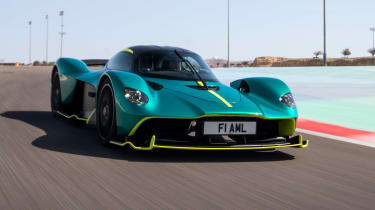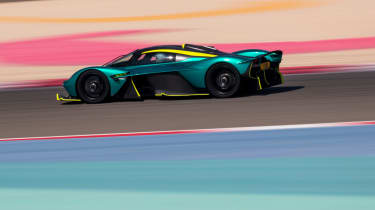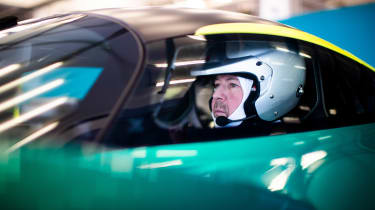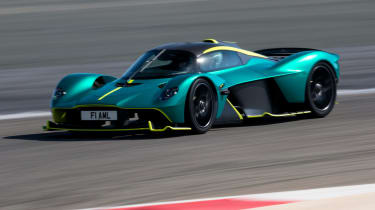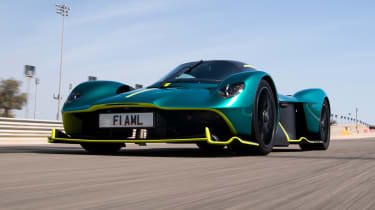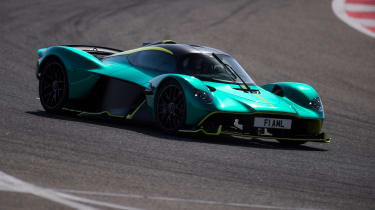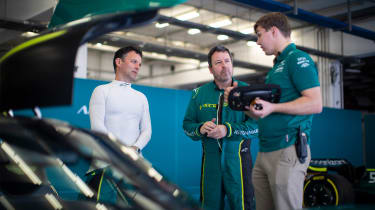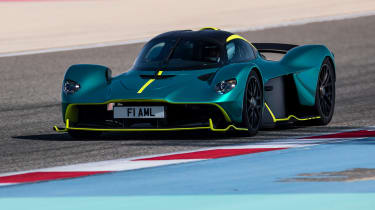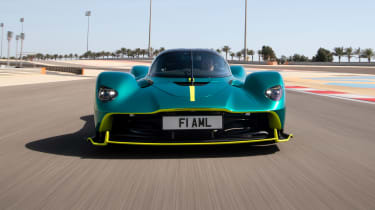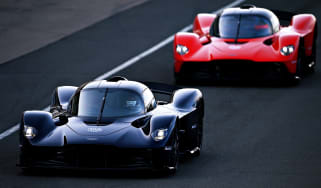Aston Martin Valkyrie 2023 review: a new realm of hypercar performance
Aston’s Newey-designed hypercar is ready at last. Is it the best thing ever to wear number plates, or too uncompromising for its own good?
Valkyrie. The car we feared we’d never drive. Yet here it is, parked proudly in the sultry warmth of the Bahrain International Circuit awaiting its audience with a select group of the world’s motoring media. Whether you’re remotely fond of Aston Martin, or simply seduced by the insanity of attempting to build and homologate Adrian Newey’s vision for the ultimate road-legal hypercar, getting behind the wheel of a finished Valkyrie is a momentous occasion.
Such has been its turbulent genesis, troubled financing and tortured gestation the Valkyrie’s plug could surely have been pulled countless times. Few cars have endured such a protracted and at times humiliating development, fewer still conducted under such public scrutiny. Still, if it was easy everyone would be doing it. Right?
That literally nobody was doing it should probably have been enough of a clue to deter Aston Martin from committing to such a moonshot, but in AML’s defence the prospect of Newey-designed high-downforce, high-revving, hybrid hypercar was utterly mouth-watering. Building a head of steam in advance of AML’s Initial Public Offering (IPO) on the London Stock Exchange certainly did the ultra-ambitious project’s sign-off chances no harm, but whichever way you slice it, the Valkyrie programme has been catnip to anyone who loves fiendishly fast cars.
And rightly so, for not since the McLaren F1 had we been treated to the prospect of a car that would re-write the rules of road-legal performance. Yes, there has been the Bugatti Veyron, but where Ferdinand Piech’s vision was a rocket sled blessed with the temperament of a VW Golf, the Valkyrie was Newey’s chance to take all his Grand Prix-winning genius and refract it through a road-going hypercar prism. For Aston, it was an irresistible opportunity to reach for the stars.
To truly understand the Valkyrie you need to unpack its constituent parts. Unfortunately, to do so you need to be an engineer with a planet-sized brain. The words to adequately describe what lies beneath the Valkyrie’s bodywork (and indeed why its bodywork is shaped the way it is) could fill a book. Handily, Aston Martin has produced just that – the 336-page ‘A Wild Ride – The Making of Valkyrie’ by Bart Lenaerts. It’s surprisingly candid and well worth a look.
It's no secret the relationship between AML and Red Bull became increasingly fractious as the irresistible force (Newey) met the immovable object (budget constraints and the realities of road homologation). In many ways this creative friction was the essence of Valkyrie, but as the programme progressed so the full scale of the undertaking became monolithic. It wasn’t so much a learning curve as a sheer rock face.
With no comparable car to refer back to or develop from, everything was conceived, designed, engineered and manufactured from scratch. Even the windscreen wiper required a year of development and employed technology taken directly from NASA’s Space Shuttle programme. Working on Valkyrie might well have been a once-in-a-career opportunity, but there’s a reason why those hardy souls who’ve seen it through have put themselves through a real-life ageing app.
Seeing the Valkyrie parked in the Bahrain pit lane, the pain of those punchy meetings and apparently impossible challenges was worth every drop of blood, sweat and tears. It’s a sensationally small and svelte machine, with smooth, organic body panels forming an insectile exoskeleton that simultaneously works and cheats the air like no car before it. Beneath the body sit gargantuan underfloor venturi tunnels that create an alien, mantis-like stance. It really is a breathtaking piece of work. One that obeys the functional demands of Newey’s punishing aero targets yet satisfies Aston’s desire for sculptural form.
Packaging-wise it’s as extreme as it gets. Years ago, I visited Aston’s now disbanded Special Vehicle Operations workshop as the first Valkyrie prototype was being assembled. I simply couldn’t believe the engine, gearbox, hybrid gubbins, electronics, fuel tank and cooling system would fit. Let alone two occupants. To be honest I’m not sure the technicians did either.
The result is bodywork vacuum packs the hardware beneath. Open the engine cover and it all-but bursts open like an over-filled holiday suitcase. The capsule-shaped cockpit is equally shrink-wrapped. Not long after the first interior buck was first shown Aston’s then-CEO Andy Palmer famously said both he and Chief Creative Officer, 6’4” Marek Reichman, could sit next to one another comfortably. How much baby oil was required to get them in (or indeed out) wasn’t disclosed. All I’ll say is climbing in requires a technique otherwise known only to drivers of Le Mans prototypes.
Once in, the driving position doesn’t feel as extreme as you might imagine. Yes, your feet are higher than your hips, but the semi-foetal position is comfortable, with your body entirely supported from shoulders to calves. The seat is fixed, but the pedals can be adjusted fore and aft. There’s also adjustment in the steering wheel, so after a bit of fenagling you can get yourself settled into an ‘elbows-in’ race driver tuck. It’s unconventional, but unmatched for occasion.
I’m surprised to feel my helmeted head knocking against the roof’s central carbon spine. Each Valkyrie has the driver’s seat tailored to its owner, but there’s a degree of ‘best guess’ with the test car’s seating to accommodate the journalists schedule to drive it each day. Apparently I have a long back, but removing the seat pad wins a few welcome centimetres of headroom. Even so, with the butterfly door closed there’s little space for lateral head movement. It’s not claustrophobic, but its decidedly snug.
Bringing the Valkyrie to life is simple. Just prod the steering wheel-mounted ‘Engine Start/Stop’ button twice to wake-up the various layers of electronics, then hold the brake and press again to start the engine. The muffling effect of helmet, balaclava and radio earplugs takes the sting out of the engine noise, but the sound that does reach your ears is a dirge, with no trace of the musicality you hear from outside. The promise of what 1155PS and 11,100rpm holds in store is ample distraction, but there’s no denying the industrial nature of the cockpit soundtrack is both intrusive and disappointing.
Thanks to assistance from the e-motor pulling away from a standstill is a cinch. It’s all very smooth, which is just as well because your first run in the Valkyrie is pretty intimidating. The value and straight-line performance are daunting, but the nerves are mostly because the aerodynamics and active suspension are a huge leap compared to anything that has come before. I have no idea how it will feel.
The ambient temperature is 21 degrees, but the tyres don’t have any meaningful heat in them. Darren Turner has helpfully advised me on best settings to use, and which to switch to later in the run, all of which puts me in a racing mindset. To be honest this is probably no bad thing, as it’s an indication of the seriousness with which you need to approach the Valkyrie. It might wear Pilot Cup 2 Michelins and ‘V12 AML’ registration plates, but the feeling you get as you trundle down the pit lane is pure race car.
First impressions are very encouraging if somewhat overwhelming. The powertrain is a force of nature from the first squeeze of the throttle. We tend to fixate on the Cosworth-developed V12’s elevated redline, but while it’s most definitely a screamer it also displaces a whopping 6.5-litres. Augmented by a Rimac-developed hybrid system, there’s slingshot torque whenever you need it.
In the first few gears you can sense the Pilot Cup 2s are wincing a bit, but the electronics nip wheelspin in the bud until those venturis start sucking the Valkyrie to the tarmac. On the plus-side the steering has satisfying weight and brilliantly measured rate of response, so despite the tension in your arms the steering is just calm enough to smooth the rough edges from your inputs. It means you quickly settle into guiding the Valkyrie towards the first few corners rather than nervously nibbling and nudging it towards an apex. The brake pedal is firm, but not rock-hard in the manner of a pure race car, so much like the steering there’s some progression and travel to help dial-in your pedal effort. For such an alien craft the basics feel remarkably intuitive.
I’ve been fortunate to drive some high-downforce competition cars in the past, none mightier than Porsche’s 919 Hybrid racer. Driving the Valkyrie is reminiscent of the LMP1 car because the first thing you get to grips with its straight-line performance, followed by the braking, with committed cornering coming only once you’ve built a degree of familiarity and trust in the machine and yourself.
The speed the Valkyrie gains between corners is of another magnitude to any road car I’ve ever driven on track. The combination of hybrid-assisted shove as you exit the corner and that searing top-end rush as you push to 11000rpm and beyond is insanely intense. For the first few laps it takes a concerted effort to explore the full rev range. Using 9000rpm feels more than ample, but when you commit to winding each gear through to the shift lights you really do access another realm. One that’s equal parts awe, exhilaration and slight unease.
It's not the raw acceleration that has your brain buffering – though the way it devours gears is pretty extraordinary – but the speed at which you approach the braking zones. The Alcon/Surface Transforms brakes have epic stopping power, but thanks to the active aero you also get a huge increase in downforce under hard deceleration. It takes a very deep breath to fully commit, but the results are genuinely eye-popping.
The most vivid demonstration of this comes at the end of Bahrain’s start-finish straight. Approached in 7th gear with the throttle pinned wide open, the Valkyrie is doing a true 200mph. Being an F1 circuit the brake marker boards only start at 150m. Even the Valkyrie can’t live with that kind of braking distance, but we’ve been told to imagine there’s a 200m board and hit the brakes there.
I won’t pretend the sensation is entirely comfortable, but the adrenaline buzz you get having successfully slowed the car and made the corner really does take some beating. It’s the bit in between that’s somewhat masochistic, for it requires you to ignore the increasingly desperate cries of your brain telling you to ‘brake-brake-BRAAAAKE!’ before finally mashing the left-hand pedal and batting down through the gears as Turn 1 snap zooms into focus.
At first everything feels like it’s happening too fast, but the trick is to look further and further ahead. It feels unnatural, but it’s all part of the recalibration process. One that you gradually get on top of lap-by-lap, but with less time to relax on the straights and so much compressed into each braking effort the Valkyrie is a ruthless and relentless test of your focus and mental stamina.
Predictably the toughest aspect of getting to grips with the Valkyrie is understanding the active suspension and downforce, then learning to trust the electronics which underpin it. For Newey, extreme aero and active suspension always went hand-in-hand, as it was the only way he could maintain a consistent ride height and therefore a stable aerodynamic platform during track use, while preserving the pliancy necessary for the Valkyrie to work on the road.
His solution combines regular springs and dampers with a torsion bar system actuated by powerful hydraulics, which serve to actively manipulate the suspension’s pre-load. This works to counter the vertical loadings generated by the aerodynamics and also give the Valkyrie active anti-squat, anti-roll and anti-dive.
The beauty of the active system is that by reacting to real-time loadings rather than simply being subjected to them as in a passively suspended car, the support (stiffness) is proportionate and only there when its needed. However, because it reacts to dynamic loadings there’s a fractional degree of latency in the system’s response. In order to mitigate this the engineers at Red Bull Advanced Technologies mapped the Valkyrie’s dynamic envelope to create a feed-forward control strategy, which is handled by a dedicated ACU (Active Control Unit). In laymen terms, not only does the Valkyrie know what it’s doing at any given time, but based on the initial driver input it has a very good idea of what will happen next. It’s still reacting, but the system’s ‘thinking’ time is significantly reduced. Clever stuff indeed.
Where the really clever stuff happens is in controlling the amount of compliance the suspension has during cornering and under braking and acceleration. At its most effective an active suspension system would remain flat as a board, but this would render it completely numb in terms of driver feedback. To provide the driver with sensory cues the Valkyrie’s active suspension has been tuned to yield by a small amount while maintaining a far higher degree of body control than a passive car. Darren Turner, who was integral to the Valkyrie’s development, describes the tuning process as akin to a recording studio’s mixing desk, with RBAT’s boffins offering an almost limitless level of adjustment.
With our test restricted to track driving only we can’t say whether the active suspension delivers on the road, which is frustrating as it’s the Valkyrie’s promised breadth of road and track capability that makes it unique. To be honest the roads in Bahrain would tell us very little, so I’m pushing for a session back in the UK once the weather warms up a bit. What I can say is that compared to a conventional passively suspended car the Valkyrie remains eerily unruffled under exceptional cornering loads. But it also requires an unusual degree of sensitivity – and way more seat time than our allotted dozen laps - to feel like you’re getting comfortable enough to consistently commit and dig into the downforce.
As you’d expect the Valkyrie is at its flattest and most tied-down in Track mode, so while there’s some perceptible initial movement as the car is subjected to accelerative, decelerative or lateral loads, it’s only for a fleeting moment before the torsion bars do their thing and the platform is stabilised. This makes it tough to feel how hard you’re working the chassis because the sensation of leaning into the available grip or traction is fleeting and finite.
An added Valkyrie-specific challenge is gauging when car is working with mechanical grip alone, and when the aerodynamics take over. This is fundamental to how confidently you can power out of a low-speed corner, peel into a series of increasingly fast direction changes or brake from high speed into an awkwardly angled low-speed apex.
In slower corners it’s easy enough to decode what’s happening on the way in or the way out and react accordingly. You need to be especially mindful of how much torque you’re asking the rear tyres to transmit before the aero makes a meaningful difference, similarly how much braking force can be absorbed. In each instance there are electronic systems to rely on – you can feel the TC intervene, ESC is very hard to detect and ABS is really only there to stop a lightly loaded inside front wheel from grabbing in the final phase if you try and brake too hard and too deep into an apex.
It’s in higher speed corners a greater leap of faith is required because you don’t have the explicit, analogue reference points to draw from. It’s also clear the 20in front and 21in rear Michelin Cup 2’s (N-rated Porsche items) are working in a realm they are not entirely comfortable, so even if you do trust in the aero you still sense the tyre is struggling to cope. You certainly don’t get the utterly outrageous feeling of limitless grip that comes from the combination of slicks and wings.
Cup R’s – not available when Valkyrie design started – would undoubtedly make a significant difference, but Aston engineers say they’d only be good for a few laps before wilting under the strain. It’s a real conundrum. One that must have been apparent from the moment the Valkyrie’s design brief pointed to road-legal tyres with acceptable wet weather properties having to deal with crushing downforce figures when driven on a racetrack.
Despite the obvious conflict, I have a suspicion it will be a much more feelsome road car. Both because the tyres won’t be worked beyond their limits, and the active suspension control will be more yielding and therefore more communicative. It’s a hunch I very much hope to confirm on some of our favourite UK roads.
As it stands, in order to protect its tyres the Valkyrie bleeds-off downforce. Under power this means not exceeding a sustained peak of more than 600kg. That figure rises to 1100kg during braking events from VMAX down to 220kph. It’s a long way from the 1800kg originally touted soon after the Valkyrie was made public, but despite this – and the inexorable creep from a projected dry weight of 1100kg to an official 1270kg – the Valkyrie remains a remarkable achievement and a uniquely intense driving experience.
Paradoxically, Newey’s complex and uncompromising vision was probably always destined to be significantly compromised. That it will take time, skill and considerable mental application to master is more a statement than a criticism, and a process that will surely bring great satisfaction to Valkyrie customers who crave new challenges and need a car with performance and personality that sets it apart from the others in their possession.
Whether this extends to its capabilities as a road car is not yet something we can confirm, but however well it may drive the horrendous cockpit noise is a major problem. Not least because a supercar’s soundtrack is a major selling point and source of pleasure, and also because driving while wearing a noise-cancelling headset deprives you of vital sensory connection.
Whether the Valkyrie will ever assume its place alongside the McLaren F1 as one of the truly seminal supercars is a question everyone would like answered, but one nobody can definitively offer. It certainly has all the ingredients, most obviously the touch of a Grand Prix design genius. It even has its own set of flaws to match the McLaren’s weak brakes and lack of roll stiffness.
Perhaps in 25-years we’ll have sufficient context to make the call. Until then the Valkyrie is an unfolding enigma. One we will hopefully come to understand better with further exposure, but like a great piece of art, one that will doubtless continue to divide opinion forevermore.
Price and rivals
At £2.5m including taxes the Valkyrie exists in the most rarefied realm. Given the singular nature of its design brief and targets there’s no direct rival. The AMG One is an obvious competitor, but its well-documented struggles with reliability are of major concern. Perhaps the closest in terms of pedigree and appeal is Gordon Murray’s T.50, which applies his own genius to the task of creating the ultimate high-downforce hypercar. When we get this pair together it will be a test for the ages.
Aston Martin Valkyrie specs
| Engine | V12, 6500cc, plus 105kW electric motor |
| Power | 1139bhp @ 10,600rpm |
| Torque | 681lb ft @ 7000rpm |
| Weight | 1270kg (dry) |
| Power-to-weight | 911bhp/ton (dry) |
| 0-60mph | |
| Top speed | 220mph (limited) |
| Basic price | £2.5 million |
| evo rating | 4 stars |
